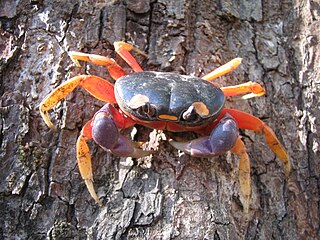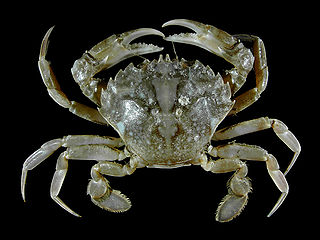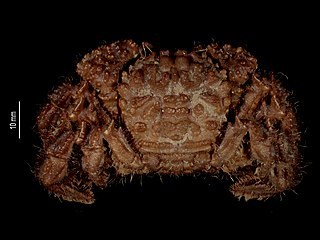
Tuerkayana hirtipes is a species of terrestrial crab.

Discoplax is a genus of terrestrial crabs. It is very closely related to the genus Cardisoma.

Gecarcinus is the type genus of the land crab family Gecarcinidae. They are found in warmer coastal regions of the Americas, including islands in the Caribbean. Four species from oceanic islands were formerly included in Gecarcinus as the subgenus Johngarthia, but are now treated as a separate genus, Johngarthia. While all members of this genus are largely terrestrial, they have to return to the ocean to breed. They are often colourful, with reddish, orange, purple, yellowish, whitish, or blackish being the dominating hues. This has resulted in some species, notably G. quadratus and G. lateralis, gaining a level of popularity in the pet trade.

Homolodromiidae is a family of crabs, the only family in the superfamily Homolodromioidea. In contrast to other crabs, including the closely related Homolidae, there is no strong linea homolica along which the exoskeleton breaks open during ecdysis. The family comprises two genera, Dicranodromia, which has 18 species, and Homolodromia, with five species.

Hexapodidae is a family of crabs, the only family in the superfamily Hexapodoidea. It has traditionally been treated as a subfamily of the family Goneplacidae, and was originally described as a subfamily of Pinnotheridae. Its members can be distinguished from all other true crabs by the reduction of the thorax, such that only seven sternites are exposed, and only four pairs of pereiopods are present. Not counting the enlarged pair of claws, this leaves only six walking legs, from which the type genus Hexapus, and therefore the whole family, takes its name. Some anomuran "crabs", such as porcelain crabs and king crabs also have only four visible pairs of legs. With the exception of Stevea williamsi, from Mexico, all the extant members are found either in the Indo-Pacific oceans, or around the coast of Africa.

Eubrachyura is a group of decapod crustaceans comprising the more derived crabs. It is divided into two subsections, based on the position of the genital openings in the two sexes. In the Heterotremata, the openings are on the legs in the males, but on the sternum in females, while in the Thoracotremata, the openings are on the sternum in both sexes. This contrasts with the situation in other decapods, in which the genital openings are always on the legs. Heterotremata is the larger of the two groups, containing the species-rich superfamilies Xanthoidea and Pilumnoidea and all the freshwater crabs. The eubrachyura is well known for actively and constantly building its own burrows. The fossil record of the Eubrachyura extends back to the Cretaceous; the supposed Bathonian representative of the group, Hebertides jurassica, ultimately turned out to be Cenozoic in age.

Metacarcinus is a genus of crabs formerly included in the genus Cancer. It includes nine exclusively fossil species and five extant species, of which four are also known from the fossil record. A molecular study using the cytochrome oxidase I gene does not support the monophyly of this genus.

Vultocinus anfractus is a species of crab, the only species in the family Vultocinidae. It has been found around the Philippines, Vanuatu and New Caledonia, and lives on driftwood. Its discovery forced a reappraisal of the relationships within the superfamily Goneplacoidea, and to the recognition of Mathildellidae, Conleyidae and Progeryonidae as separate families.

Homola barbata is a species of crab in the family Homolidae.
Villalobosius is a genus of crabs in the family Pseudothelphusidae, containing a single species, Villalobosius lopezformenti. It lives in the northern part of the state of Oaxaca, Mexico, on the Isthmus of Tehuantepec, and is adapted to a troglobitic lifestyle.

Karstarma is a genus of karst-dwelling crabs formerly included in Sesarmoides.

Gelasimus vocans is a species of fiddler crab. It is found across the Indo-Pacific from the Red Sea, Zanzibar and Madagascar to Indonesia and the central Pacific Ocean. It lives in burrows up to 50 centimetres (20 in) deep. Several forms of G. vocans have been recognised, with their authors often granting them the taxonomic rank of full species or subspecies.

The family Homolidae, known as carrier crabs or porter crabs, contains 14 genera of marine crabs. They mostly live on the continental slope and continental shelf, and are rarely encountered. Members of the Homolidae have their fifth pereiopods in a sub-dorsal position, which allows them to hold objects in place over the rear half of the carapace. The objects carried include sponges, black corals and gorgonians, and this behaviour may be a defence mechanism against predators. Some species have been observed carrying living sea urchins in a symbiotic relationship which allows them to benefit from the protection of the urchin's dangerous spikes.

Demania is a genus of crabs in the family Xanthidae, containing the following species:
Jacforus cavatus is a species of crab in the monotypic genus Jacforus in the family Xanthidae.

Cancrocaeca xenomorpha is a species of troglobitic (cave-dwelling) freshwater crab from Sulawesi, the only species in the monotypic genus Cancrocaeca. It has been described as the world's "most highly cave-adapted species of crab".

Limnopilos naiyanetri, commonly referred to as the Thai micro crab or pill-box crab, is a freshwater hymenosomatid crab endemic to Thailand. Its presence has only been confirmed in the Tha Chin River. The species was described in 1991 and represents the type species of Limnopilos. The Thai micro crab was first introduced to the aquarium hobby in 2008 when it was imported to Germany by the tropical fish importer Aquarium Glaser GmbH, and has slowly grown in popularity with aquarium hobbyists. It remains a relatively rare species on the market and detailed information on the husbandry of this species is scarce.

Limnopilos is a genus of small hymenosomatid crabs endemic to Southeast Asia. The genus was described by Christina Chuang and Peter Ng in 1991, who identified the new species Limnopilos naiyanetri and distinguished it from the closely related genus Hymenicoides. Its true taxonomic classification was debated for several years, but in 2007 the discovery of a new species of crab in this genus solidified the distinction between Limnopilos and Hymenicoides. Many aspects of the genus Limnopilos are still poorly understood. Their ecology and natural history have not been studied in detail, and their reproductive cycle remains mysterious.

Paromola is a genus of crabs within the family Homolidae. Members of the Homolidae genus have their fifth pereiopods in a sub-dorsal position, which allows them to hold objects, such as sponges, black corals and gorgonians, over the rear half of the carapace, in a possible defence mechanism against predators.
Gordonopsis mazupo is a species of deep-sea porter crab. It was discovered in the South China Sea in 2021 and described as a new species in 2024.
















